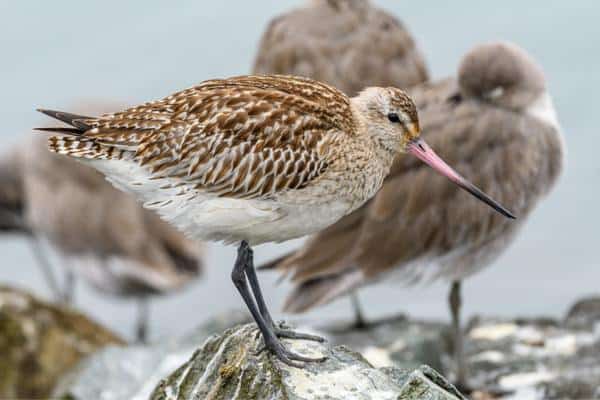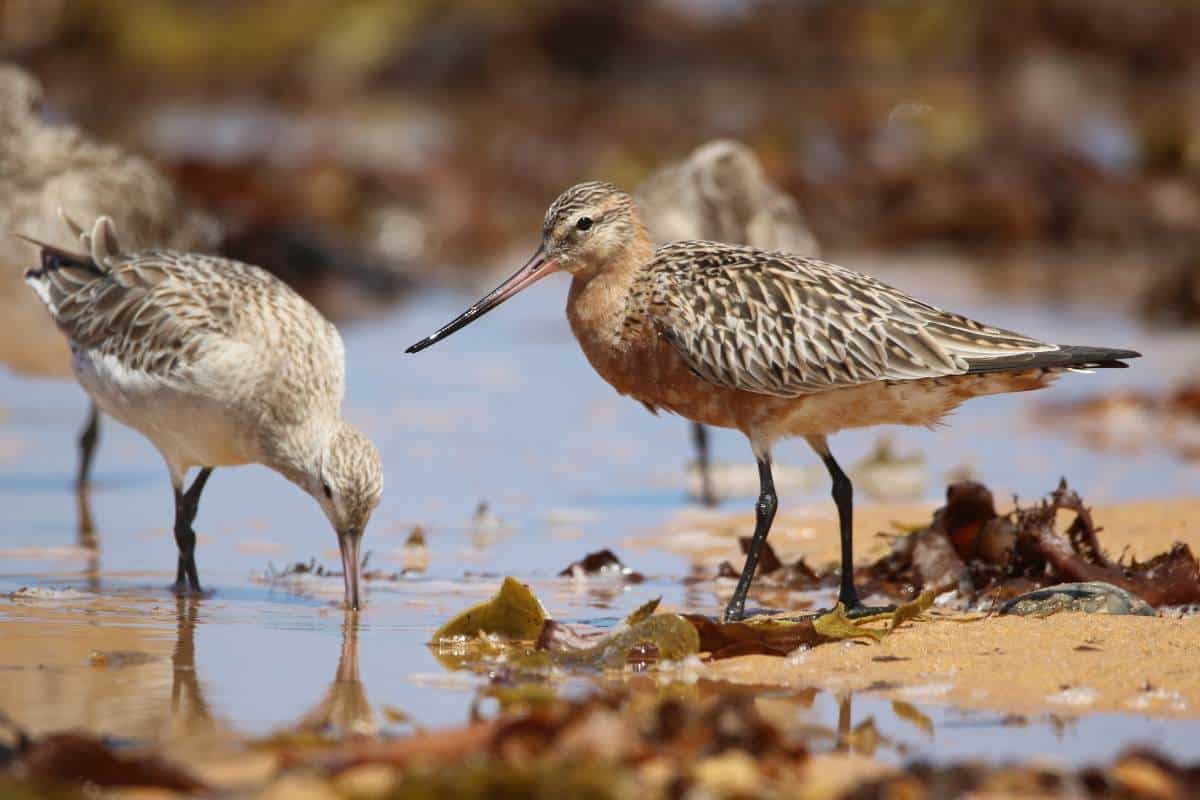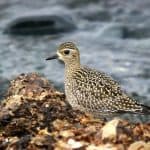Common Name: Bar-tailed Godwit
Scientific Name: Limosa lapponica| Size | Diet | Range in Hawaii | Status in Hawaii |
|---|---|---|---|
| 16 in. - 18 in. | insects, worms, crustaceans, mollusks | Kaua'i, O'ahu, Moloka'i, Maui, and Big Island | Near Threatened |
The Bar-tailed Godwit, also known as Limosa lapponica, is a fascinating bird that is known for its incredible migration habits. These wading birds are found all over the world, from Europe and Asia to Australia and New Zealand. But did you know that the Bar-tailed Godwit can also be found in Hawaii? That’s right! Despite being a migratory bird, some Bar-tailed Godwits have made Hawaii their year-round home. Let’s take a closer look at this remarkable species and learn more about their unique characteristics and habits.
Bar-tailed Godwit
Appearance

The Bar-tailed Godwit is a striking bird known for its distinctive appearance. It has a medium to large size, measuring approximately 16 to 18 inches (40 to 45 centimeters) in length. The species displays sexual dimorphism, with males and females differing slightly in size and plumage coloration.
These birds have long, slender bills that curve slightly upwards, providing them with a characteristic and easily recognizable feature. During the breeding season, adult Bar-tailed Godwits have a striking reddish-brown plumage on their upperparts, which contrasts with their pale underparts. Their underwings are predominantly white, and their tails are barred with black and white, hence their name “Bar-tailed” Godwit.
In contrast, outside the breeding season, the birds undergo a dramatic change in appearance. They molt into a more subdued gray-brown plumage, helping them blend into their coastal habitats and providing camouflage. This non-breeding plumage lacks the vibrant reddish-brown tones seen during the breeding period.
Diet
The Bar-tailed Godwit has a specialized diet that is well-suited to its coastal habitat. These birds are primarily carnivorous, feeding on a variety of invertebrates found in mudflats, estuaries, and shallow waters.
Their diet mainly consists of insects, worms, crustaceans, mollusks, and small marine invertebrates. Bar-tailed Godwits use their long bills to probe into the wet soil or mud, searching for prey. They have a remarkable ability to detect and capture buried prey by touch, using their sensitive bill tips to feel for movement or vibrations.
During their migratory journeys, Bar-tailed Godwits rely on food sources along their flight path. They are known for their extraordinary long-distance flights, and they strategically time their migrations to coincide with the availability of food resources in various stopover locations.
Nesting

Bar-tailed Godwits exhibit an interesting nesting behavior as part of their breeding cycle. These birds are ground nesters, meaning they build their nests directly on the ground in open areas such as tundra, meadows, or coastal marshes.
The female Bar-tailed Godwit takes the primary responsibility for nest building. She constructs a simple depression in the ground, often lined with a shallow layer of vegetation or other materials. The nest is typically well hidden amidst the surrounding vegetation, offering some level of camouflage and protection.
Once the nest is prepared, the female lays a clutch of usually four eggs, although clutch sizes can range from two to five eggs. The eggs are pale-colored and have variable markings, providing some degree of camouflage. Both male and female parents take turns incubating the eggs, with each incubation shift lasting several hours.
The incubation period lasts approximately three to four weeks, during which the parents diligently tend to the eggs, ensuring they remain warm and protected. After hatching, the chicks are precocial, which means they are relatively independent and able to leave the nest soon after hatching. They are able to walk, swim, and forage for food with the guidance of their parents.
Bar-tailed Godwits typically breed in the Arctic regions of North America, Europe, and Asia. After the breeding season, they embark on their long migratory journeys to their wintering grounds in other parts of the world, where they spend the non-breeding period before returning to their breeding sites in subsequent years.
Behavior
The Bar-tailed Godwit displays fascinating behaviors throughout its life cycle. These behaviors contribute to their survival, migration, and successful breeding.
One remarkable behavior of Bar-tailed Godwits is their long-distance migration. They undertake one of the longest known migrations of any bird species, traveling thousands of miles each year between their breeding grounds in the Arctic and their wintering grounds in coastal areas of Europe, Africa, Asia, and Australasia. This impressive feat involves non-stop flights lasting several days, during which they rely on stored fat reserves to fuel their journey.
During the breeding season, Bar-tailed Godwits establish and defend territories, engaging in courtship displays to attract mates. Males perform aerial displays, including flight songs and wing-flapping, to exhibit their strength and attract females. Once pairs form, they engage in mutual preening and bonding behaviors.
These birds are highly social and often gather in large flocks during migration and at wintering sites. Flock behavior offers benefits such as increased foraging efficiency, predator detection, and navigation. They communicate with each other using a variety of vocalizations, including calls and alarm signals.
Bar-tailed Godwits are primarily diurnal, being active during the day and resting at night. They forage in coastal mudflats, probing the ground with their long bills to locate and capture small invertebrates, such as worms, insects, and mollusks. Their bills have specialized sensory receptors that aid in detecting prey beneath the mud or sand.
When threatened, Bar-tailed Godwits may exhibit defensive behaviors, such as alarm calls, taking flight, or displaying distraction displays to divert attention away from their nests or young. During the breeding season, male Bar-tailed Godwits defend their territories by displaying aggressive behaviors towards intruders, including aerial chases and vocal warnings.
Habitat

The Bar-tailed Godwit inhabits a range of coastal and wetland habitats throughout its distribution. During the breeding season, it prefers nesting in the tundra regions of the Arctic, where it constructs nests on the ground in areas with low vegetation cover. These nesting sites are typically found in moist meadows, marshes, or areas near lakes and ponds.
During migration and wintering periods, Bar-tailed Godwits utilize a variety of habitats. Along their migration routes, they rely on estuaries, mudflats, and intertidal zones as important stopover sites. These areas provide abundant food resources, including invertebrates such as worms, mollusks, and crustaceans, which the godwits feed upon.
In their wintering grounds, Bar-tailed Godwits can be found in coastal areas such as sandy beaches, saltmarshes, and mangrove swamps. They may also frequent shallow coastal lagoons, deltas, and brackish water habitats. These habitats offer suitable feeding grounds and protection from predators.
Range
The Bar-tailed Godwit, a migratory bird species, can be found in Hawaii, specifically in the Northwestern Islands and other islands such as Kaua’i, O’ahu, Moloka’i, Maui, and Hawai’i. While a few individuals of the species, belonging to the baueri subspecies, choose to spend their winters in the Northwestern Islands, the majority of Bar-tailed Godwits are more commonly observed there during the fall and spring seasons.
This preference is likely due to the unsuitable habitat for wintering in the Northwestern Islands. Nonetheless, occasional sightings of these birds across the other Hawaiian Islands have been recorded, with some individuals even observed over multiple years.
Conservation Status
The Bar-tailed Godwit (Limosa lapponica) is classified as “Near Threatened” by the International Union for Conservation of Nature (IUCN). This designation reflects concerns about the species’ declining population and the various threats it faces.
Bar-tailed Godwits rely on specific habitats, such as coastal mudflats and wetlands, for foraging and resting during migration and wintering. However, these habitats are under significant pressure from human activities, including habitat loss and degradation due to coastal development, pollution, and disturbance. These factors have a direct impact on the availability of suitable feeding areas for the birds.
Interesting Facts
1. Longest known nonstop flight
The Bar-tailed Godwit holds the record for the longest known nonstop flight of any bird species. Individual godwits have been tracked traveling over 8,435 miles (13,560) in a single journey from Alaska to New Zealand without taking a break.
2.Remarkable Migrations
Bar-tailed Godwits undertake one of the most impressive migratory journeys in the avian world. They breed in the Arctic regions of North America and Eurasia, then fly thousands of miles south to spend the winter in coastal areas of Europe, Africa, Asia, and Australasia.
3.Adaptive Bill Length
Their bills are uniquely adapted for their feeding habits. During the breeding season, they have relatively short bills suited for foraging on insects and other invertebrates in the tundra. In contrast, during migration and winter, their bills lengthen, enabling them to probe deeper into the mud and sand to capture prey.
4.Sex Role Reversal
Bar-tailed Godwits exhibit a rare form of sex role reversal in which females are larger and more brightly colored than males. This reversal is believed to be related to their breeding strategy, where males incubate the eggs and care for the young.
5.Flexible Feeding Techniques
Bar-tailed Godwits employ a variety of feeding techniques to obtain their prey. They use their long bills to probe into the mud or sand, or they may walk slowly and pick up prey items from the surface. They are also known to perform bill-sweeping behaviors to catch small insects in mid-air.
6.Vocal Communication
Like many other bird species, Bar-tailed Godwits use vocalizations to communicate with each other. Their calls include a series of melodious whistling notes, often delivered in flight or during territorial displays.
Frequently Asked Questions
1. How do Bar-tailed Godwits manage to fly such long distances without rest?
Bar-tailed Godwits have several adaptations that enable them to undertake long flights without resting. They have specialized flight muscles and a high-energy metabolism that allows them to sustain prolonged flight. Additionally, they strategically time their flights to take advantage of favorable winds and weather conditions, conserving energy during their journey.
2.Do Bar-tailed Godwits form lifelong pair bonds?
Bar-tailed Godwits do not typically form lifelong pair bonds. During the breeding season, males establish territories and compete for females. However, they may mate with multiple females, and the responsibility of incubating the eggs and caring for the young is primarily undertaken by the males.
3.How long can Bar-tailed Godwits live?
Bar-tailed Godwits have relatively long lifespans for migratory birds. In the wild, they can live up to 20 years or more. However, their exact lifespan can vary depending on factors such as predation, habitat conditions, and overall health.




